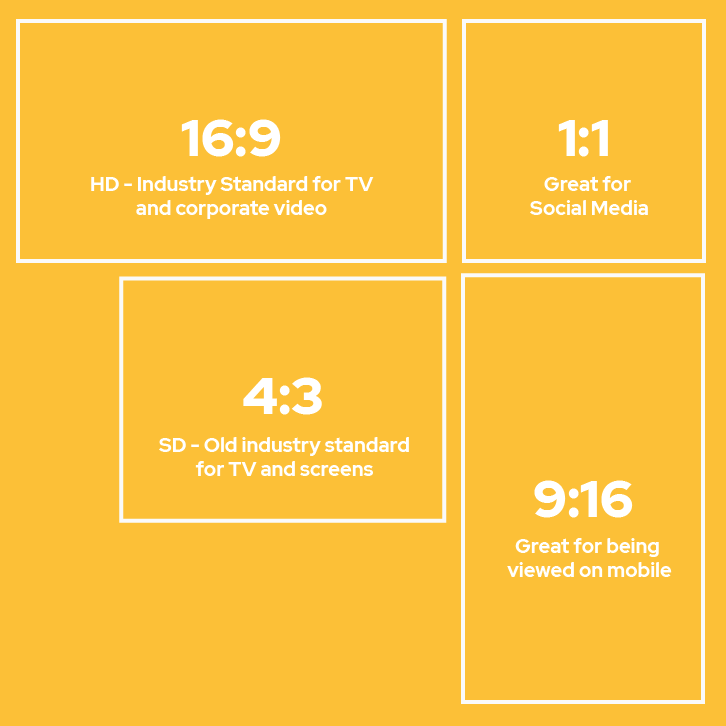In the world of video production, there’s a term that often gets thrown around without much explanation: aspect ratio.
You might have come across this term when uploading a video to social media or preparing a presentation, but what exactly does it mean, and why does it matter? Let’s delve into the world of aspect ratios and uncover why they’re crucial in the realm of video creation.
Understanding aspect ratios
Simply put, aspect ratio refers to the proportional relationship between the width and height of a video frame. It’s usually expressed as two numbers separated by a colon, such as 16:9 or 4:3. The first number represents the width, while the second represents the height.
For instance, a video with an aspect ratio of 16:9 means that for every 16 units of width, there are 9 units of height. This ratio determines the shape and size of the video frame you see on your screen.
Why are aspect ratios important?
Aspect ratios play a significant role in how we perceive and interact with video content. Different platforms and mediums have their preferred aspect ratios, and using the wrong one can lead to unpleasant viewing experiences or cropping issues.
Imagine watching a video that’s stretched or cropped incorrectly; it can distort the visuals and distract from the intended message. By understanding aspect ratios and choosing the appropriate one for your project, you can ensure that your content looks its best across various platforms and devices.

Choosing the right aspect ratio
Now that we grasp the importance of aspect ratios, let’s explore some common ratios and where they’re best used:
16:9
This is perhaps the most widely used aspect ratio, commonly known as widescreen. It’s ideal for most online platforms, including LinkedIn, YouTube, Vimeo, and social media sites like Facebook and Instagram. With its wide format, it offers a cinematic viewing experience and works well for storytelling and promotional videos.
4:3
Historically used for standard-definition television, the 4:3 aspect ratio has become less common in today’s digital landscape. However, it still finds its place in certain contexts, such as presentations, where compatibility with older equipment is necessary, or with documentaries and short films that want that ‘arty feel’.
1:1
Popularised by Instagram, the square aspect ratio is perfect for mobile viewing and social media platforms that prioritize square content. It provides a balanced frame and is particularly suited for showcasing products or capturing attention in a cluttered feed. This is a great option for a multitude of social media platforms that are primarily accessed through mobile devices.
9:16
With the rise of mobile usage, especially for consuming video content, the vertical 9:16 aspect ratio has gained prominence. It’s ideal for platforms like TikTok, Snapchat, and Instagram Stories, where vertical viewing is the norm. It also has the highest engagement rates on mobile as it fills the majority, if not the whole screen. Great for B2C products and services that are promoted primarily through social media.
Are there any weird and wonderful options?
Of course there are, we have created animated content for a huge digital panel on the side of an EV charging station (a bit like the adverts you see on the sides of bus stops), we’ve created content for a very specific video brochure size and perhaps one of the most challenging projects we’ve done was for a huge defence and security conference in Singapore, attended by the US Secretary of Defence and his UK counterpart, many Four-Star Generals and Senior Ministers and Heads of State from across the world. It was a bespoke set with a single screen, but the screen was over 30ft in width with individual sections that were raised in different points and different sizes. A mathematical nightmare for our lead animator, Amy, but we smashed it. The video is below so you can get a sense of the insane complexity! So in answer to the above question, absolutely yes!
Conclusion
In conclusion, aspect ratios are a fundamental aspect of video production that shouldn’t be overlooked. By understanding the significance of aspect ratios and selecting the appropriate one for your project, you can ensure that your content resonates with your audience and delivers the intended message effectively.
Whether you’re creating a promotional video for social media, a presentation for work, or a cinematic masterpiece, choosing the right aspect ratio sets the stage for a successful viewing experience. So, next time you embark on a video project, remember to consider the aspect ratio—it’s the key to unlocking visually compelling content that engages and captivates your audience.

